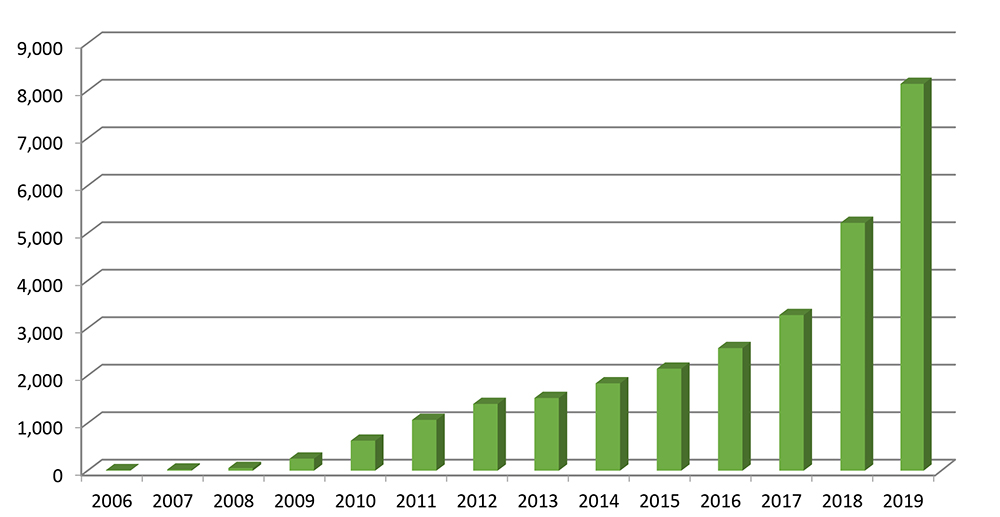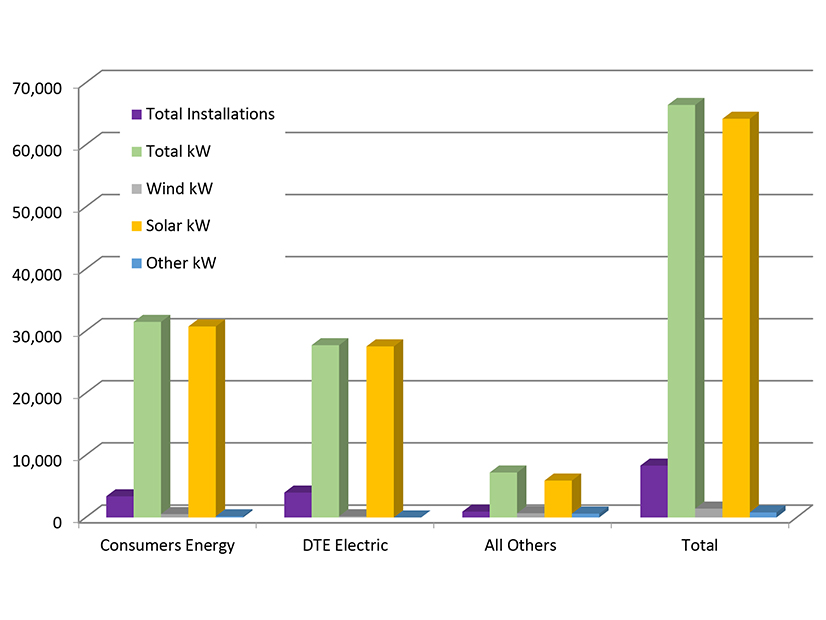LANSING, Mich. — The Michigan Public Service Commission is seeking to revamp its interconnection process to create more certainty for generation developers and a fast-track for small projects.
In the request for rulemaking filed with the state Office of Administrative Hearings and Rules, the commission said its current interconnection and net metering rules, issued in 2009, are “outdated and need to be replaced.” It cited the increase in solar, wind and energy storage, 2016 legislation limiting net metering and its 2015 order calling for an update of its rules under the Public Utility Regulatory Policies Act (Case U-17973).
It also said the new rules would reflect updated interconnection standards from the Institute for Electrical and Electronic Engineers and FERC’s 2018 Order 841, which required RTOs to allow energy storage resources full access to their markets. (See FERC Rules to Boost Storage Role in Markets.)
The proposed rule would not resolve disputes over compensation for distributed generation and has no bearing on legislation now sitting in the state House Energy Committee to reverse the 2016 legislation that allows utilities to limit their net-metered generation to 1% of their average in-state peak load for the preceding five calendar years (H.B. 4236). The cap limits generators of up to 20 kW to 0.5%, with 0.25% for generators of 20 to 150 kW and 0.25% for methane digesters of up to 150 kW.
But it would be a good starting point toward resolving those other issues, PSC Chair Dan Scripps said in an interview with NetZero Insider. “It’s one piece of the puzzle. We wanted to make sure we had the interconnection procedures right … as we continue to work through the compensation and cap issues, both in our orders and … in the legislature.”
The biggest drivers for the new rule are the “vastly increased” volume and growing complexity of interconnections, particularly large solar projects, said Julie Baldwin, manager of the PSC’s Renewable Energy Section.
“For the larger projects I’m hoping that [the process] will be sped up,” she said in an interview. “I think what we’re going for more is predictability. We want a developer when they file an application that’s complete … to know how long it’s going to take so they can plan. Because under the old rules the utility could do a study … but then the developer could take six months [to] decide if they wanted to go forward. So you had projects behind [them] kind of waiting to see [what the developer in front would decide]. It really just gummed up the process.”
Under the new rule, applicants have deadlines of 10 to 60 business days to inform the utility of their decisions on whether to proceed from various mileposts or withdraw their application.
Baldwin said the PSC hopes the increased technical capabilities of inverter-based resources, as captured in IEEE’s new standard (1547-2018), will make it easier to integrate distributed energy resources into the grid.

The 53-page draft rule was crafted in consultation with a workgroup of consumers, utility officials and others formed in response to a 2018 PSC order (U-20344). A public hearing on the draft will be held Oct. 20, with comments due Nov. 1. The final rule must be approved by the PSC; Scripps said he hopes the rule will win approval by May 2022.
Amy Bandyk, executive director of the Citizens Utility Board of Michigan, said the rule would “significantly” modernize the interconnection process. “It has some improvements for behind-the-meter generation, but [it] mostly clears up procedures for utility-scale solar systems that are connected directly to the distribution grid. It has compromises amongst interest groups but should somewhat reduce delays, costs and contention. As we increasingly deploy solar generation to meet future electricity needs, this will be important.”
“We spend a lot of time talking about who’s driving this process, and I don’t think it’s us,” Scripps said. “Folks are interested in more distributed generation because it’s cheaper; because there are climate concerns; because the technology’s improved. But I also think we have a responsibility not to be overrun by those changes. So that’s … what’s really informing a lot of this. We don’t see rule updates driving the changes taking place, but we also need to be ready for those changes.”
What’s in the Rule?
Under the rule, DG projects would proceed under one of several tracks, primarily based on their size:
Simplified Track: Level 1 (20 kW or less, with equipment certified under IEEE standards) and Level 2 (a certified project between 20 and 150 kW) projects would be processed using the simplified track, give the utility 10 business days to perform its initial review screens and notify the applicant if any interconnection facilities, distribution upgrades, further study or modifications are needed.
Non-export Track: Applications for DERs that will not inject energy into an electric utility’s distribution system could be evaluated under the non-export track, with the utility required to provide the applicant results within 20 business days.
Fast Track: Level 3 (an uncertified project of 150 kW or less or a certified project between 150 and 550 kW) and Level 4 (between 550 kW and 1 MW) projects not proposing to connect with the utility’s high-voltage distribution system would be eligible for the fast track, which would require the utility to complete its initial review within 20 business days. The utility could not require a supplemental review or a system impact study if the DER passes the initial review screens, which evaluate the size of the DER relative to the distribution circuit. Interconnections to a radial circuit, for example, would be limited to 15% of the line section’s annual peak load. Supplemental reviews include screens for minimum load, voltage and power quality and safety and reliability.
Study Track: Interconnection applications not eligible for the simplified, non-export or fast track would be subject to the study track, which also could apply to applicants who failed review screens under the other processes. Level 5 (more than 1 MW) applications would be required to use the study track. This process involves individual studies, in which interconnection applications are processed in the order in which they were put into the study track, or batch studies, in which all applications have equal priority. The process includes a system impact study, which provides a nonbinding list of facilities required to accommodate the application and nonbinding estimates of their costs. It is followed by a facilities study, which provides a “detailed and itemized” estimate of the cost of the required equipment, engineering, procurement and construction work, and an estimated timeline for the completion of construction.

